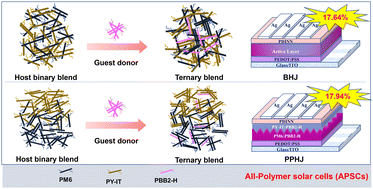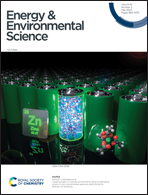Achieving 17.94% efficiency all-polymer solar cells by independently induced D/A orderly stacking†
Abstract
All-polymer solar cells (APSCs) with outstanding mechanical and thermal stability are considered as having the most potential application in flexible power supply systems. However, the strong interchain entanglement between conjugated polymers generally produces active layers with poor nanoscale phase separation and low mixing entropy, thus making it difficult to control the crystallization and morphology, which severely restricts the advancement of the photovoltaic performance. Hereby, a polymer donor PBB2-H with feasible miscibility was used that could penetrate into the donor/acceptor (D/A) aggregation domains to optimize the molecular arrangement and phase-separation scale of the all-polymer active layer, so as to achieve efficient exciton and carrier utilization. The PM6:PBB2-H:PY-IT ternary APSC with a bulk heterojunction (BHJ) structure achieved a 17.64% efficiency and a high thickness tolerance. Interestingly, the penetration of PBB2-H could also effectively promote the formation of more mixed phases and independently optimize the D/A orderly stacking, showing a unique advantage in constructing an ideal morphology in a pseudo-planar heterojunction (PPHJ) active layer. As a consequence, the ternary APSC with the PPHJ structure obtained a champion efficiency of 17.94%, and also exhibited excellent shelf stability and photostability. Overall, this work reveals that the use of a well-miscible third component can induce orderly D/A stacking, and has great potential for helping create high-performance APSCs.



 Please wait while we load your content...
Please wait while we load your content...